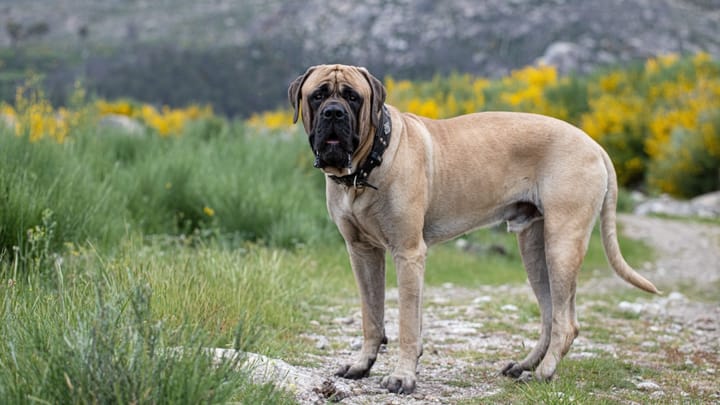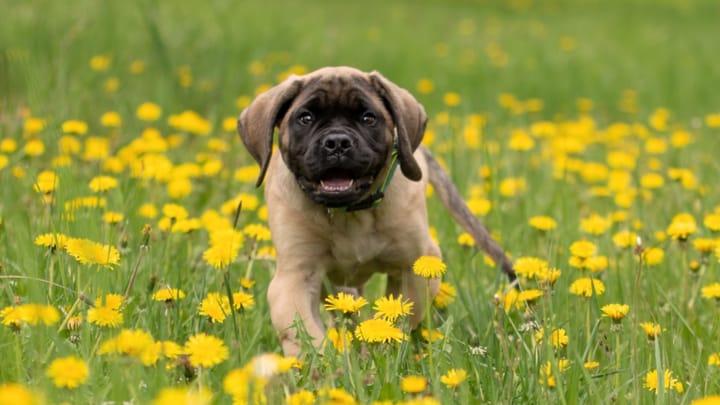Mastiff
Other names : English Mastiff, Old English Mastiff


The Mastiff is the ideal companion for lovers of XXL-sized dogs. To wit, weighing close to 220 pounds, this dog’s abnormal size is as overwhelming as the joy one discovers getting to know him. This dog is well-rounded, gentle, has a heart of gold- in direct proportion to his size! He can sometimes prove to be somewhat phlegmatic, but is nevertheless a big softie who cannot stand to be away from his human family.
|
Life expectancy |
The Mastiff has a life expectancy of between 10 and 11 years |
|
Temperament |
|
|
Size |
Large
|
|
Adult size |
Female
Between 26 and 30 in
Male
Between 30 and 33 in
|
|
Adult weight |
Female
Between 143 and 176 lb
Male
Between 187 and 220 lb
|
|
Coat colour
The coat can be fawn, apricot-fawn or brindle-fawn. The muzzle, ears, and nose are black. The dominating presence of white on the body, chest or paws is not admissible by official standards. |
Red Sand |
|
Type of coat
The coat is short. The coat is spread out flatly throughout the body. Please note that it is thicker around the shoulders, the neck, and the back of the dog. |
Short |
|
Eye colour
The eyes are hazel, as dark as possible. |
Brown
|
|
Purchase price |
The Mastiff costs between £700 and £1120 |
This breed has been at the brink of extinction more than once already, due to some excesses in the breeding of certain lineages- most notably, inbreeding. This has unfortunately led to certain genetic weaknesses that contemporary dog-breeding is trying to amend.
By the way, contrary to popular belief, the Mastiff is not subject to the law introduced in January 1999 regarding so-called dangerous dogs. In fact, it is not a part of dogs in these categories, neither first nor second.
More details about the Mastiff
Mastiff: Origins and history
In 55 BC, when Caesar’s legions invaded the British isles, they came face to face with two types of dogs: the first was stocky, with a disproportionately big head, and a short yet powerful jaw- of which the poor legionnaires’ calves soon became thoroughly convinced. This dog was highly likely the Bulldog’s ancestor, and had some of the modern-day Bullmastiff in him. The second dog was of exceptional dimensions, more of a lion than a dog in fact! He was the direct descendant of the assyro-babylonian mastiffs, imported to England by the Phoenicians some 500 years prior to the Roman invasion. He made the Epirus Molossians- whom the Romans considered to be excellent warriors- look like helpless little companion pups. As a result, upon conquering Britain, the Romans brought back these impressive English dogs with them, dubbed them ‘Pugnaces Britanniae’ (or ‘British Pugnaces’), and used them in arena fights with the most ferocious of animals. The Mastiff is a direct descendant of the latter dogs.
Physical characteristics of the Mastiff
Of massive size, the Mastiff has a particularly respect-inducing physical appearance. The head, looked at from any angle, appears rather square. The skull is wide in between the ears, flat, but wrinkled when the dog is alert. The muzzle is short, and wide underneath the eyes: it must appear clearly delineated, and be significantly deep between the tip of the nose, and the lower extremity of the mandible. The stop is pronounced, but not sharp. The eyes are small. The ears are small, fine, hung quite high, and close to the cheeks. The body is massive, robust, and symmetrical. The tail, hanging low when the dog is at rest, curves slightly upwards when he is animated.
Mastiff: Characteristics
Mastiff: Behaviour
Training a Mastiff
This Mastiff is not the most docile of his category but will nevertheless be receptive to training if it is firm, coherent and respectful of the principles of positive training.
This mighty molossian will not tolerate any form of brutality at the hands of his master and will be much more inclined to cooperate if it is those good behaviours that will be compensated and reinforced.
At times unaware of the extent of his strength, the training will have to prioritise leash-led walking, pull-free, so that when the dog becomes an adult, walking him will be a breezy, pleasant affair!
At any rate, with a dog of such proportions, it is advised to call on a professional dog trainer who will accompany the owners in the training process.
Mastiff: Lifestyle
Breed compatibility Mastiff
Mastiff: Purchase price
The price of a Mastiff varies depending on its origin, its age, and its gender. You have to estimate an average of between £700 and £1120 for a dog that is part of the Kennel Club.
Regarding the monthly budget, it is quite significant since you must set aside around £80 per month to be able to cater to this giant’s needs.
Mastiff: Shedding
Average
This giant’s hair loss is moderate but existing, especially during moulting seasons such as spring and autumn. During these periods, he will require a daily brush.
Mastiff: Grooming
The maintenance of this massive dog is not as complicated as it may initially seem. His short coat needs only a few regular brushes, ideally once a week. Actually, his propensity towards being patted make these pampering sessions very easy and pleasant.
His eyes and ears will have to be checked and cleaned scrupulously, with the help of physiological lotions or specialised products (avoid cotton swabs for the ears, a sterile compress is better suited). Moreover, his nails will have to be clipped approximately once a month.
Mastiff: Health
The life expectancy is estimated at 11 years.
This large molossian is, by all accounts, a robust dog, but does experience some health issues due to its sizeable constitution.
In times of significant heat, this massive dog will need to have constant access to fresh water and a cool spot in the shade, or indoors, to take breaks.
Even if his coat is thicker in some parts of his body, he is not suited for extremely cold temperatures. He won’t appreciate much having to sleep outside in the winter.
With a well-adjusted diet and daily walks, this dog will be able to stay in shape and keep his weight in check.
- Orthopedic pathologies (due to rapid growth)
- Hip and elbow dysplasia
- Cruciate ligament injuries
- Gastric Torsion Syndrome
- Osteosarcoma (bone cancer)
- Canine Multifocal Retinopathy (ocular disease)
- Cystinuria (kidney malfunction)
- Cardiomyopathy
- Entropion
- Hyperthyroidism





